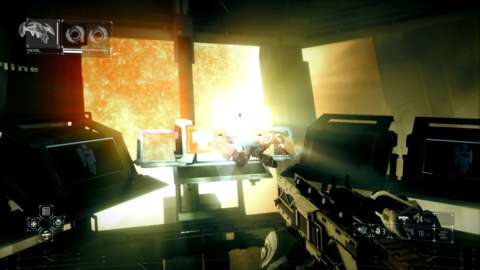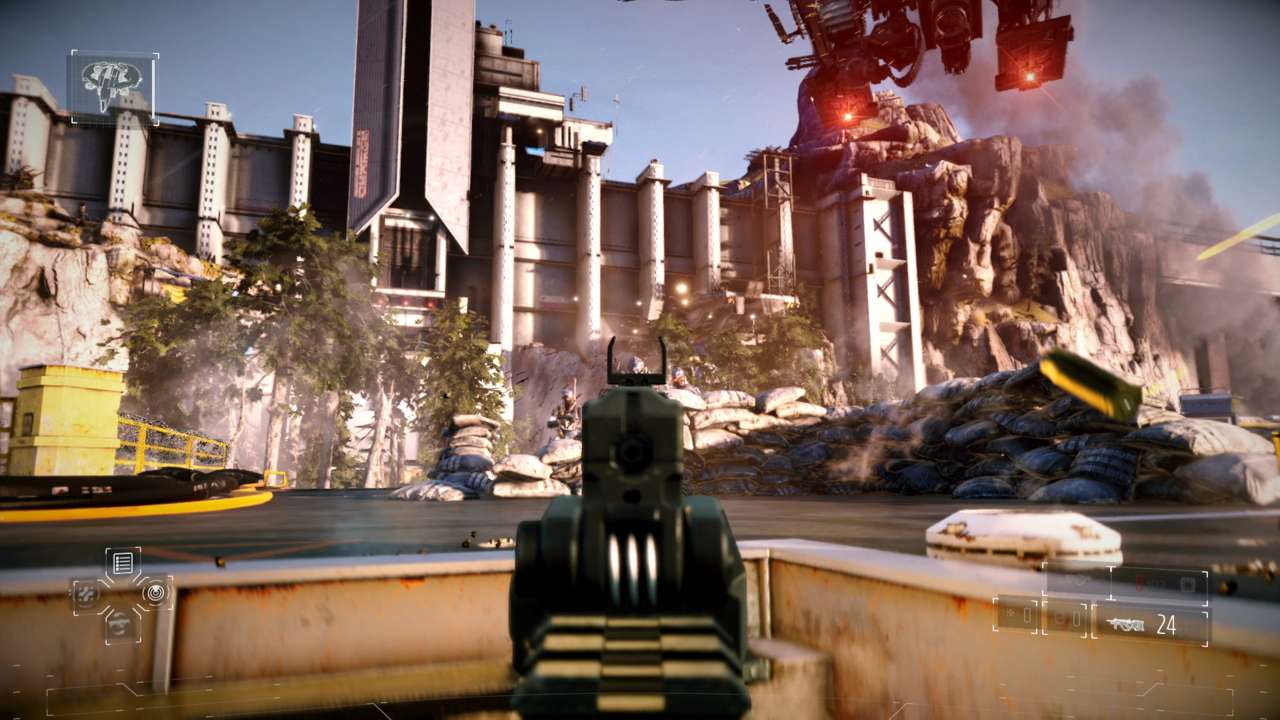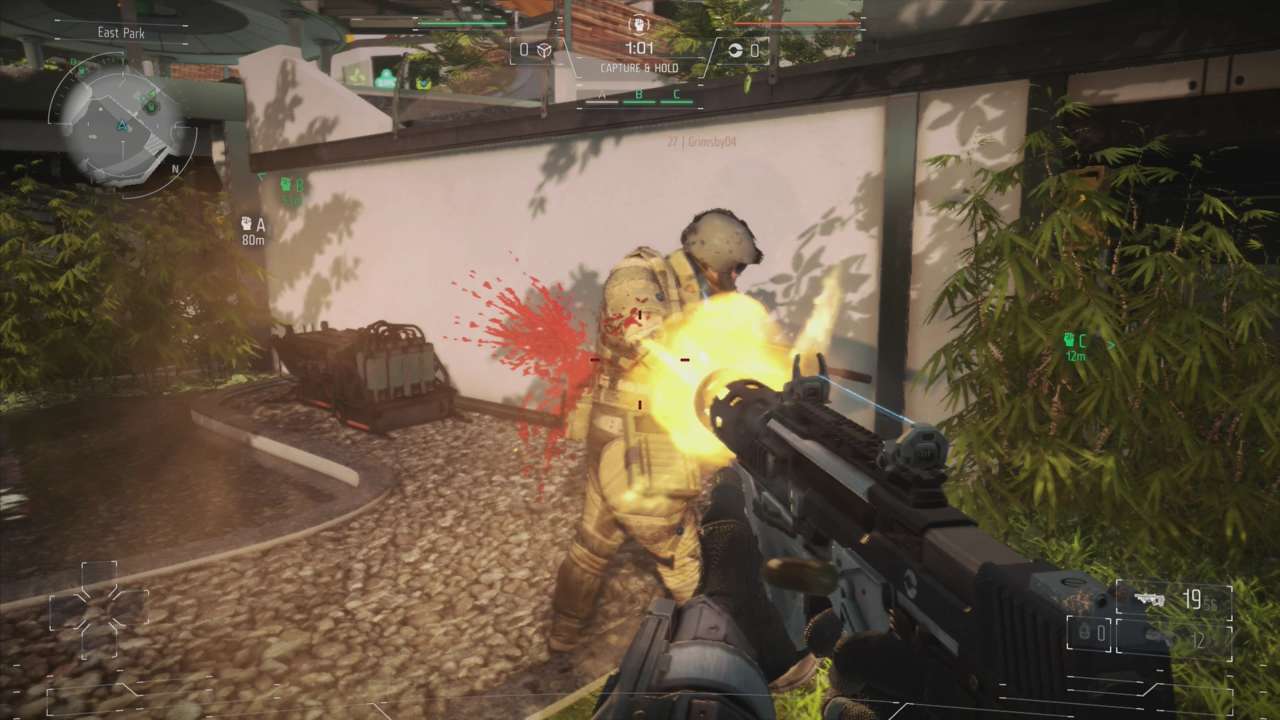The Killzone series has often been lauded for its technological merits, but its artistic merits go too often unheralded. To define these games through terms like "IBL sampling" and "particle vertices" diminishes their striking beauty. Like its predecessors, Killzone: Shadow Fall is likely to be described through a technical lens, and the game certainly deserves praise for how many polygons it packs into its most expansive landscapes. Its buttery-smooth performance is also bound to earn kudos: Shadow Fall smooths away the frame rate hitches and texture pop-in we've become so accustomed to in even the most visually impressive console shooters.
More wonderful, however, is the art the software's ones and zeroes convey. Shadow Fall brings the ongoing conflict between the series' warring races to planet Vekta, which provides a stark contrast to the hazy Helghan environs we explored in the previous two games. Vekta's gleaming blue seas and futuristic cityscapes have supplanted Helghan's reddened skies and intimidating dust storms. Where the Helghast were at the mercy of their harsh climate, the Vektans have made peace with nature. Their capital city may reach into the clouds and spread across the terrain, but birds still fly freely between skyscrapers, and massive mountains provide a sweeping backdrop.
This is a beautiful setting for a first-person shooter, and a fine showcase for the visual possibilities new consoles introduce. At first you might think that Shadow Fall doesn't represent a giant graphical leap forward, but it isn't displaying the typical shooter's limited spaces. You traverse a fair share of corridors, but you also float through the vastness of space and engage Helghast soldiers on stretches of rocky, open land. Shadow Fall's levels more closely resemble Crysis 2 and Crysis 3's areas than any prior Killzone game's, yet the game displays such expanses with more clarity than Killzone 3 displayed its tighter zones.
It's too bad that where Killzone 3 packed its maps with exciting action sequences, Shadow Fall's campaign forgot to bring the thrills.
Killzone: Shadow Fall uses its downtime to remind you of how pretty it is, but not in service of any particular narrative effect.
The basics are perfectly sound, at least. Shadow Fall's sense of weight doesn't match Killzone 2's, but its shooting and movement are exceptionally fluid. Each gun is enjoyable to shoot--the shotgun in particular, which blasts enemies backwards with satisfying oomph. Shadow Fall also makes a go at diversification. Zero-G sequences have you floating towards airlocks and you avoid the watchful eyes of patrolling Helghast in a stealth mission. You move from firing at soldiers while avoiding high-speed commuter trains to hacking spider drones and initiating their self-destruct sequence. The visual variety is commendable. The rain pelts metal walkways during a nighttime sojourn through an industrial installation, in contrast to the sunlit cliffs that play home to your early shootouts.

The problem is that none of these activities are particularly interesting. Helghast soldiers roam the larger areas, but they are too few in number, and don't offer much challenge. There are precious few large-scale shootouts; instead, you typically face a small handful of foes who take your bullets and collapse into a heap of ragdoll limbs without too much trouble. More troublesome is how much time you spend doing relatively little but moving through the game's admittedly gorgeous spaces.
Granted, many shooters take time to breathe between shootouts, building their worlds and developing their characters by way of slower-paced exploration and dramatic cutscenes. Killzone: Shadow Fall uses its downtime to remind you of how pretty it is, but not in service of any particular narrative effect. In one of several weightless sequences, you accompany a sluggish space capsule as it meanders towards its destination, blasting the buzzing drones that appear like clockwork and hinder your progress. The sequence wears out its welcome long before you arrive at the airlock. It doesn't build tension, deepen your understanding of the conflict, or stimulate you with great action. It's simply boring--one more insubstantial graphical set piece. Elsewhere, you join a checkpoint queue that recalls Half-Life 2's opening, but where Valve's masterpiece used overheard dialogue and televised broadcasts to introduce you to the oppressive City 17, this noninteractive wait provides few thematic details you don't already know, making its length seem unnecessary and self-indulgent.

Shadow Fall announces its potential in later levels, where you shoot explosive canisters and joyfully ride the resulting billows of energy to higher ground. In this tense chapter, you must consider positioning and cover opportunities lest a colossal security contraption liquidate your physical assets. When facing the nameless Helghast grunts, it was the battles against shielded troopers that I most enjoyed. These meanies give you a reason to make use of the little flying gadget that accompanies you on your journey. Typically, I used it as an offensive distraction, commanding it to draw enemies' attention by firing at them, which allowed me time to execute them with a deadly blast from my rifle, or with a mighty knife stab. Your attack drone is most handy because it weakens and stuns shielded enemies, giving you a chance to strike them down as they stumble.
Guerrilla Games remembered what drew me and many others to the front lines of online war, and it's here that Shadow Fall emerges from the rubble and flies into the electric skies.
The drone also serves as a rappel device, allowing you to slide to lower levels, though the game makes little use of this mechanic, and it's surprisingly easy to plummet to your death if you don't carefully select where to attach the hook. I rarely used the drone's shielding capabilities given how easy Shadow Fall is on its default difficulty level, and in fact, I was surprised once I'd finished to see how many full chapters I completed without once succumbing to death. The exception to this rule was a chapter that has you zigzagging between collapsing superstructures in a frustrating freefall sequence that prizes its action-film theatrics over proper playability. It's difficult to admire wanton destruction when the rules aren't well established.
One element of Killzone: Shadow Fall that's clearly superior to its predecessors is its story, which explores an aspect of the Vektan-versus-Helghast conflict that had gone curiously underscrutinized. The red-eyed Helghast are hardly moral lighthouses, but the Interplanetary Strategic Alliance's righteousness has never been called into question. Now, as Shadow Marshal Lucas Kellan, you face the atrocities your own faction has committed. The surviving Helghast have been offered a new home on Vekta, where the two races are physically separated by a security wall and engage in an uneasy cold war. Lucas's initial loyalties are established in the opening chapter, which gives Shadow Fall an intimate touch Killzone has always lacked, and Kellan ultimately finds himself torn between his fiery father figure and the mandates of his own conscience. The story beats a predictable drum, and Lucas is an underdeveloped hero who is only remarkable for what he does as opposed to who he is, but at no point did I look back longingly on Rico and Garza's meathead chatter.

Where Shadow Fall's campaign eases back on the action, its class-based multiplayer options front-load the thrills, and as always, the Warzone is at the center.
Warzone isn't a mode so much as a template. It allows you to mix and match various modes such as Team Deathmatch, Capture and Hold, and many others. Classic Warzone randomizes these modes and is an instant thrill. Guerrilla Games is a master of map design, and Killzone: Shadow Fall maintains the series' high bar. The Remains map recalls Killzone 2's finest online moments. Crumbling buildings and massive blast holes disrupt your line of sight and keep you looking up and down as well as all around, listening for the telltale footsteps and rat-a-tat-tats that betray nearby soldiers. Combatants weave through corridors and converge in the courtyards and open streets that shape the most frenzied battles.
Penthouse is another treasure among the 10 maps, featuring a rotating core that causes its four entryways to open and close, bringing an extra tactical concern to the firefight. An attempt to be clever and wait for one entrance to become accessible could end with a knife in your back when the entrance behind you clears instead. Players taking alternate routes are guaranteed to clash as they circle the surrounding hallways, and the victor in a surprise one-on-one encounter is typically the one who hits the trigger--or who pulls out a knife--first.
Cloaked teams slinked through a forest armed only with sniper rifles, desperate to stay alive.
On these maps and others, varying objectives pull you into action hotspots, where a dozen or more combatants vie for control. A well-placed spawn generator (which allows teammates to spawn outside of your base) can turn a calm theater into an unstable battlezone where a sudden glut of Helghast soldiers descend upon a group of defending Vektan security agents. The rotating modes keep you on your toes, but it isn't just the mad dash to the next capture point that lights my fire. After one leg of the battle ends, there's a restless pause while teams await instructions, giving me a chance to gun down unfocused fighters who let down their guard.
Shadow Fall features three classes--scout, assault, and support--in contrast to Killzone 3's five, though classes possess more than just two special abilities. While I dabbled as a scout, I'm not one to snipe from the shadows or cloak myself from view. I gravitated to the support class, in part because I love the shotgun's potency, but also because I enjoyed earning points each time a teammate used a spawn beacon I'd placed. I also enjoyed coming to the rescue of fallen comrades in need of revival, in part because I could summon a healing drone to the battlefield. What a nice change from using a defibrillator to shock a friend back to life.

Warzones let you arrange match types as you see fit, but you aren't limited to the default versions. You can customize matches in significant ways, and if you're worried about how well they'll play out online, you can always populate the match with bots. (The scarcity of bot support in other online shooters continues to exasperate me.) You can mess with the number of capture beacons, change time limits, and limit players to specific classes and weapons. Or try creating asymmetrical teams, forcing one to use pistols and allowing the opposing team to cloak themselves. You can significantly alter the pace of a multiplayer match by altering the parameters. I'm excited to see what anarchy results in a match with everyone armed with electrical squad cannons and carrying maximum ammo, and the personalized warzones I did play were notably different from each other. In one creation, cloaked teams slinked through a forest armed only with sniper rifles, desperate to stay alive, knowing that this match type didn't support respawning. In another match type, pump-action shotguns ruled the day. Each player possessed a special ability that allowed for hurried sprinting, turning a Capture and Hold match into a bloody close-range tug of war.
As much as I enjoyed my online time with Killzone: Shadow Fall--and as much as I will enjoy lots more time with it, unlocking perks that allow me to personalize my weapons--I missed Killzone 3's jump pack, which brought a nifty nimbleness to the battlegrounds. I missed it in Shadow Fall's disappointing single-player campaign, too, which sorely needed a shot of adrenaline. Where I look back fondly on Killzone 2's finest single-player moments, the moments I recall here are those in which I wandered through corridors and rocky meadows wondering where the bad guys were. Luckily, Guerrilla Games remembered what drew me and many others to the front lines of online war, and it's here that Shadow Fall emerges from the rubble and flies into the electric skies.